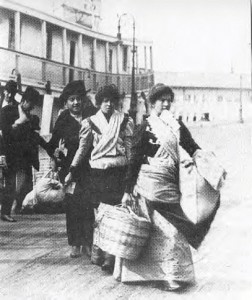 A new source that documents Irish emigrant women in late 19th and early 20th century New York has recently been published online. The records originate with Our Lady of Rosary Mission, established in 1883 in response to the campaigning of Charlotte Grace O’Brien.
A new source that documents Irish emigrant women in late 19th and early 20th century New York has recently been published online. The records originate with Our Lady of Rosary Mission, established in 1883 in response to the campaigning of Charlotte Grace O’Brien.
Charlotte Grace O’Brien was born in 1845 in Limerick the daughter of Irish Nationalist, William Smith O’Brien. After his involvement in the failed uprising of 1848, William Smith O’Brien was sentenced to death. Following petitions signed by over 80,000 people, O’Brien’s sentence was commuted to transportation for life and he was sent to Tasmania, although he returned to Ireland in 1856.
Irish Emigrant Women
Later in her life Charlotte Grace O’Brien became involved in the plight of Irish emigrants. After reading J.F. McGuire’s book, the Irish in America she travelled to Queenstown [Cobh] in Co. Cork where she witnessed the arrival of scores of women and girls, seeking passage to America. To provide shelter for these departing women, O’Brien opened a boarding house in Queenstown. She also accompanied a medical officer to inspect the ships that her boarders were intending to travel on.
She followed the emigrants to America and in 1882 arrived in New York to see first-hand the circumstances that Irish emigrant women were living in. In an effort to combat the appalling conditions in which she found her fellow countrywomen, she oversaw the establishment of Our Lady of the Rosary Mission in 1883, which was dedicated to emigrant aid. Father John Riordan, the first chaplain at Castle Garden, officially established the Mission of Our Lady of the Rosary for the Protection of Irish Immigrant Girls on October 1, 1883.
The object of the Mission was to provide information and counselling to emigrants and to provide temporary accommodation where emigrants could be safely sheltered. By 1908 the Mission reported that they had seen nearly one third of the 300,000 Irish girls and women who passed through the Port of New York between 1883 and 1908.
The Mission maintained ledgers which recorded the name of the emigrant woman, her age and county of birth and the ship on which she arrived. In fact the ledgers appear to be organised by ship arrival. On the opposite page is a record of to whom the emigrant was sent and their destination address. It is also possible to identify sisters who travelled together or emigrant girls who were reunited with family already settled in America. A significant number of the women came from counties Mayo, Galway, Cork, Kerry and Roscommon, departing from Queenstown. The ledgers record details of 60,000 women who were assisted by the Mission.
Five of the ledgers for the Mission, which date from 1897 to 1940 have now been transcribed and digitised and can be found at the Watson House website, the home of the Mission since 1885. It is possible to search by name or to search the ledgers by the ship on which the emigrant arrived. The same website hosts a detailed exhibition on the Irish woman’s emigrant experience in America.
